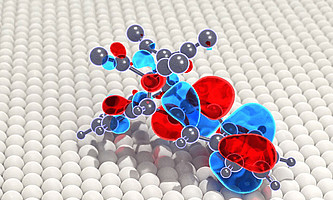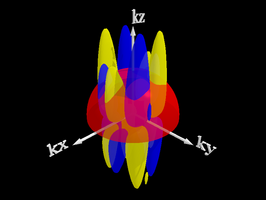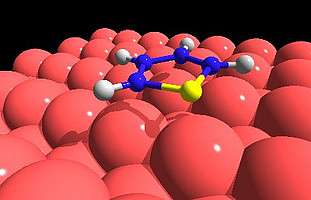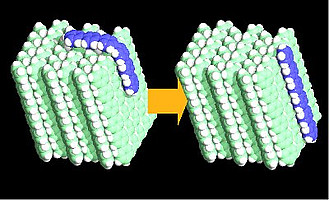Projects
Orbital Cinema (ERC synergy grant, 07/2023 - 06/2029)
Directly watching in slow-motion videos how electrons move in quantum mechanical orbitals and how this motion shapes the functionalities of condensed matter is the goal of „Orbital Cinema“, which has been funded by the European Research Council (ERC) with a synergy grant. In our project, we (Stefan Tautz, Ulrich Höfer, Rupert Huber and myself) will for the first time record the motions of electrons in molecules in space and time on their intrinsic length and time scales in slow-motion videos. This will allow us a direct view on the inner workings of quantum leaps and charge transfer processes and to reveal how chemical reactions can be controlled by electromagnetic fields and light waves.
Exploring the foundations of photoemission tomography (2018-2022)
Photoemission tomography is a combined experimental and theoretical approach which uses the angular distribution of electrons which are photo-emitted by UV-light from well-oriented layers of molecules on crystalline surfaces to image of molecular orbitals. Our team, consisting of experimental surface scientists from the University of Graz and the Forschungszentrum Jülich and experts in metrology and synchrotron radiation from the Physikalisch-Technischen Bundesanstalt Berlin, will conduct a series of well-designed experiments to trace out the range of validity of the so-called plane wave final state approximation. Theoretical support by quantum mechanical ab-initio calculations and simulations of photoemission cross sections from my group will complement the project.
Project Information: FWF I3731 / DFG
Selected Publications: Science 371, 1056-1059 (2021), ACS Nano 14, 15766-15775 (2020), Nature Communications 10, 3189 (2019)
Quantifying photoemission of organic molecular films (2014-2018)
This project aims at a fully quantitative description of the photoemission cross section of organic molecular films by improving (i) the theoretical description of initial state energies and wave functions, (ii) by incorporating scattering effects in the final state, and (iii) shedding light on the polarization dependence of the photoemission cross section. The theoretical developments and simulation results achieved in this project will be closely connected to corresponding ARPES experiments. This allows, on the one hand, for a benchmarking of theoretical methodologies and, on the other hand, for a most sophisticated understanding of the electronic structure of organic molecular films beyond current standards.
Project Information: FWF P27649-N20
Selected Publications: Nature Communications 6, 8287 (2015), PCCP 17, 1530-1548 (2015) Nature Communications 8, 335 (2017)
Understanding photoemission of organic molecular films (2011-2014)
Although thin films of conjugated organic molecules are entering the marketplace as the active elements in various optoelectronic devices, the basic understanding of their electronic structure is lacking. By means of angle-resolved photoemission spectroscopy (ARPES) we investigate the electronic band structure of highly oriented molecular films. Moreover, we are able to show that the ARPES intensity can be utilized to map electron distribution of individual molecular orbitals.
Project Information: FWF P23190-N16
Selected Publications: Science 326, 702-706 (2009), Phys. Rev. B 84, 235427 (2011) PNAS 111, 605-610 (2014)
Van der Waals forces
Sparse matter is abundant and has both strong local bonds and weak van der Waals (vdW) forces between atoms or meolecules. The standard approximations in density functional theory are known to fail for these latter non-local dispersion forces. We make use of a recently developed vdW density functional and have demonstrated that vdW forces are indeed crucial for binding in organic molecular crystals as well as between organic / metal interfaces.
Selected Publications: Phys. Rev. Lett. 99, 176401 (2007), New J. Phys. 11, 053010 (2009).
Organic film growth
Detailed understanding of growth mechanisms in organic thin-film deposition is crucial for tailoring growth morphologies, which in turn determine the physical properties of the resulting films. By means of atomic force microscopy the existence of an additional barrier for step-edge crossing (Ehrlich-Schwoebel barrier) has been demonstrated. We have been able to calculate this energy barrier by seraching for the transition state on a multi-dimensional potential energy surface and revealed a barrier height in accordance with experiment. The unexpected mechanism involves the bending of the molecules over the step edge.
Selected Publications: Science 321, 108 (2008), Scientific Reports 6, 38519 (2016), Advanced Functional Materials 29, 1903816 (2019).
Excitons in organic semiconductors
To properly account for electron-hole interactions in the optical spectra of solids, one has to invoke many-body perturbation theory, i.e., to solve the Bethe-Salpeter Equation (BSE) for the electron-hole (e-h) correlation function. This procedure has turned out to be a benchmark for ab-initio calculations of optical properties of semiconductors and insulators leading to bound e-h states (excitons). We have shown that the incorporation of these e-h correlations leads to substantial exciton binding nergies in organic semiconductors, where have placed special emphasis on the role of intermolecular interactions and dependence on molecular size.
Selected Publications: Phys. Rev. Lett. 89, 056405 (2002), New J. Phys. 11, 125010 (2009), Phys. Rev. B 86, 085107 (2012).





